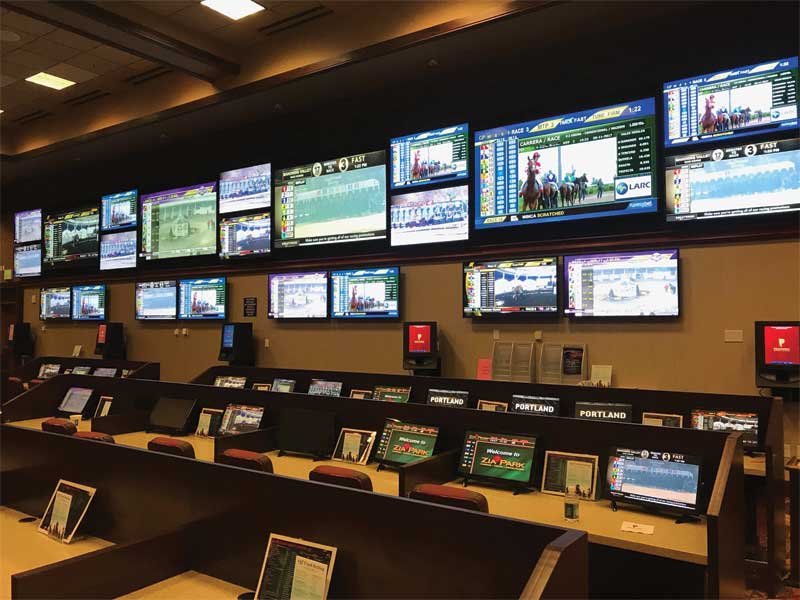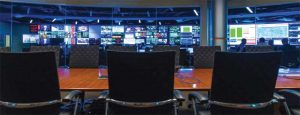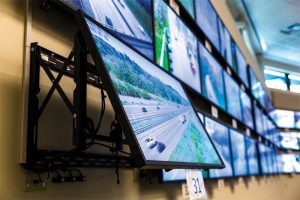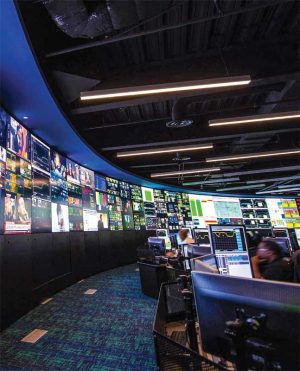Choosing the right display for video walls
by | 22 February 2019 3:17 pm
 [1]
[1]Video walls can be found in different types of settings, including corporate offices, retail stores, transportation hubs, and sports venues, as well as command and control facilities.
By Keith Yanke
Over the past decade, video walls have become an increasingly popular digital signage choice. This is because they are particularly effective at engaging people and delivering messages efficiently. They offer larger, higher resolution images than a single display, and they can be built to almost any configuration to fit a specific space or purpose.
Video walls have found homes in many different types of settings, including corporate offices, retail stores, transportation hubs, and sports venues, as well as command and control facilities. When deciding which type of video wall installation is appropriate for the customer’s needs, one basic decision is determining which of the two types of technologies—liquid crystal display (LCD) or direct view light-emitting diode (dvLED)—is best for the specific application. LCD and dvLED displays have very different features and benefits.
Part solid, part liquid
LCD panels are manufactured by inserting a layer of liquid crystal—a substance that is part solid and part liquid—between two sheets of glass. When electricity is applied to this layer, the crystals shift to create an image. However, as the crystals do not produce their own light, some type of backlighting is needed to display the image. Ironically, LEDs are the most popular source of backlighting for LCD panels.
LCD panels are bright and provide high-resolution images at a modest cost. They also have slim depths and are energy efficient. One major disadvantage of these panels, however, is that they require a bezel. LCDs have been a popular choice for video walls, but when the panels are connected to create a video wall, these bezels are visible and breakup the overall image.
Although bezel widths continue to narrow, they can still create a visual distraction for some LCD video wall installations.
Converting electricity into visible light
 [2]
[2]In general, a large screen that will be viewed from afar can have a relatively high pixel pitch, but a screen that will be viewed from close up should have a small pixel pitch.
A LED is a tiny semi-conductor that converts electricity into visible light. In a LED panel, each colour pixel has one red, one blue, and one green LED. The combination of these three colours enables the ability to create trillions of colours. In an LED panel, each semi-conductor produces light, unlike an LCD panel, in which the backlight passes through the liquid crystal layer. This is where the name ‘direct view’ LED originates.
LED panels have many advantages, including high brightness, superior contrast and viewing angles, long-life, and energy efficiency, and are suitable for indoor and outdoor applications. Depending on the installation, these panels are ideal for video walls as they do not require bezels. This means there are no seams in the middle of the wall to distract viewers.
Choosing the right panel
LCD panels have traditionally been the popular choice for video walls, particularly for indoor applications, and dvLEDs have been the go-to choice for outdoor installations. However, due to advances in LED technology, dvLEDs are now challenging the dominance of LCDs for indoor video wall applications.
Selecting the best video wall solution for a specific indoor installation can be challenging. The following are some considerations sign installers should keep in mind:
Pixel pitch
Measured in millimetres, pixel pitch is the distance between the centre of an LED pixel and the centre of an adjacent pixel. A screen with a smaller pixel pitch has more pixels overall and provide higher resolution images than a screen with a larger pixel pitch. In general, a large screen that will be viewed from afar can have a relatively high pixel pitch, but a screen that will be viewed from close up should have a small pixel pitch.
Image quality
Look for sharp images and a solution that provides factory colour calibration.
Brightness
Although this is more of a concern for outdoor installations, brightness should still be considered for indoor video walls. The ambient lighting conditions of an interior environment need
to be considered to ensure the video wall will have sufficient brightness to provide excellent view ability.
 [3]
[3]For easier installation and lower-cost maintenance, video wall panels should allow for front and rear access.
Contrast
A high-efficiency LED chip will ensure deep contrast, and black mask will boost the contrast ratio.
Power consumption
With the proper content and brightness settings, dvLED panels can be more energy efficient than LCD panels, which can save the client money. Power consumption specifications should be compared to determine the differences between models.
Heat dissipation
As LEDs emit heat, as well as light, heat dissipation can be a concern for dvLED panels. Therefore, to better understand how each system manages heat dissipation, and what requirements are needed for the particular application, it is always a good idea to consult with manufacturers and/or suppliers.
Build quality
Indoor video walls should be robust enough to hold up to installation and exposure to environmental conditions and minor bumps. Installers should look for strong, lightweight panels with alignment features that enable precise placement. It is also important to use mounting structures specifically designed for each particular panel and to ensure the equipment provider supplies the structure with the display.
 [4]
[4]For many customers, video wall installations that include hardware and services are an ideal fit.
Front and rear service access
For easier installation and low-cost maintenance, video wall panels should have front and rear access.
Cost
LCD panels are less expensive than LED panels; however, the gap is narrowing. Pixel pitch is the primary contributor to the higher cost of LED displays; therefore, it is important to work with the equipment supplier to ensure the installation’s pixel pitch matches the client’s budget, image quality expectations, and content type.
Long-life
LED panels have lengthy longevity ratings. For example, models rated at 80,000 hours of use will provide more than 13 years of service. When a client chooses a video wall panel, it is important to ensure the display can be colour calibrated. The main reason for this is usually due to repairs when new LED panels are installed to replace older units. Having the ability to calibrate each display to closely match other panels can help avoid/eliminate square sections of the video wall being brighter or darker than others. Ultimately, calibration will make the video wall look like new and enable the content to look its best. It can also prove to be essential in the later years of the LED’s lifespan.
Turnkey
For many customers, choosing a video wall installation that is a complete, end-to-end solution that includes hardware and services will be an ideal fit.
The big picture
Thanks to recent advances in dvLED technologies, customers considering an indoor video wall installation now have options beyond the traditional choice of LCD displays. To steer clients in the right direction, it is important to decide whether the use of LCD or dvLED panels is the best choice for the project at hand. This decision depends on many factors; however, by matching the client’s needs with the benefits of the different technologies available, a cost-effective, long-term signage solution can be discovered.
As senior director of product marketing for NEC Display Solutions of America, Keith Yanke is responsible for providing strategic direction for display products in the Americas. Since joining NEC in 1994, he has spent time in sales, engineering, and marketing for projectors and flat panel displays, ensuring products are meeting the market’s ever-changing needs. He can be reached via e-mail at keithyanke@necdisplay.com[5].
- [Image]: https://www.signmedia.ca/wp-content/uploads/2019/02/Picture-1.jpg
- [Image]: https://www.signmedia.ca/wp-content/uploads/2019/02/Picture-4-1.jpg
- [Image]: https://www.signmedia.ca/wp-content/uploads/2019/02/Picture-5-2.jpg
- [Image]: https://www.signmedia.ca/wp-content/uploads/2019/02/Picture2-1.jpg
- keithyanke@necdisplay.com: mailto:keithyanke@necdisplay.com
Source URL: https://www.signmedia.ca/choosing-the-right-display-for-video-walls/